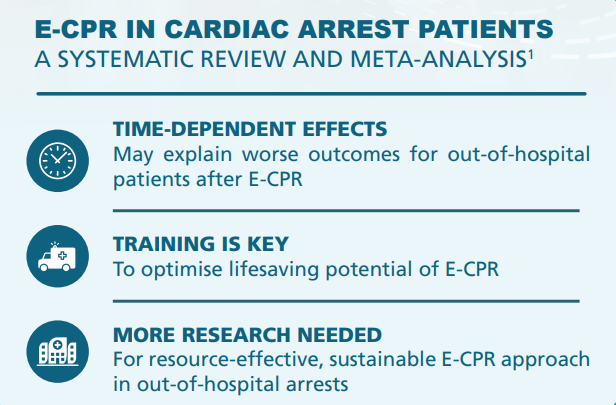Analysing E-CPR In Cardiac Arrest Patients
Where time and experience are of the essence
PULSE Issue 42 | February 2024
Cardiac arrest is a life-threatening condition where the heart stops
beating due to a lack of oxygenated blood supply to the heart and
brain, necessitating immediate treatment to prevent complications.
Statistics show survival rates for out-of-hospital cardiac arrest patients
are less than 10%, while in-hospital cases range between 15% to 25%.

Conventional Cardiopulmonary Resuscitation (C-CPR) is the standard
method for reviving the heart, involving chest compressions,
defibrillation, and medications. However, recent research has explored
Extracorporeal Cardiopulmonary Resuscitation (E-CPR), which aims
to maintain blood circulation while the heart is being revived. E-CPR
involves redirecting blood from the body through a heart-lung machine,
which removes carbon dioxide and pumps oxygenated blood back to
the brain and other vital organs of the body.
Nevertheless, it’s important
to note that this procedure is time-consuming and resource-intensive,
and several overseas studies comparing E-CPR to C-CPR have yielded
mixed results, with major bleeding being a common side effect of E-CPR.
NUHCS researchers conducted a systematic review and meta-analysis using data from 11 high-quality studies published within the last 20
years, to compare the clinical outcomes of cardiac arrest patients who
received E-CPR versus C-CPR.
According to research, the mortality rate of patients who’ve received
CCPR was 80.7% while those who underwent ECPR is 75.1%, which is two-thirds lower than that of CCPR despite its seemingly small percentage
difference. Moreover, a quarter of ECPR patients experienced good
brain recovery, as compared to CCPR patients which only 13% saw such
results, and survival rate among ECPR patients after hospital discharge
were analysed to be higher.
While E-CPR was associated with lower mortality rates for in-hospital
cardiac arrests, this was not observed for out-of-hospital cases.
Researchers attributed this difference to longer transport time of
emergency medical services, resulting in further organ damage that
affects treatment efficacy. This does not imply that E-CPR is ineffective
in out-of-hospital cases, but it calls for further exploration of methods
that can enhance survival rates, such as streamlining emergency
services. Analysis shows hospitals with more experiences performing
E-CPR procedures achieve better outcome, indicating the importance
of rigorous training and extensive experience in realising E-CPR's life-saving potential.
The research findings encourage the implementation of E-CPR for in-hospital cardiac arrests, highlighting the vital role of clinicians and
policymakers in devising cardiac arrest treatment protocols. This
especially pertains to employing E-CPR as the primary approach over
C-CPR, and considering factors that can improve E-CPR survival rates.
While E-CPR has the potential to improve cardiac arrest survival rates,
this study emphasises the need for further research to build sustainable
systems that efficiently evaluate patients’ eligibility for E-CPR, and
optimising the healthcare system to implement E-CPR effectively,
maximising patient outcomes and resource efficiency.
